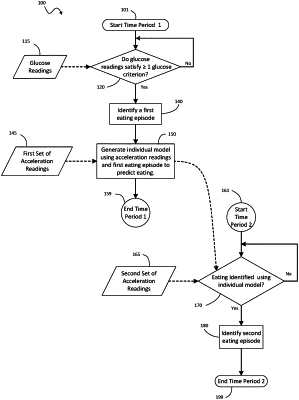| CPC A61B 5/4866 (2013.01) [A61B 5/0205 (2013.01); A61B 5/1123 (2013.01); A61B 5/14532 (2013.01); A61B 5/6824 (2013.01); A61B 5/6825 (2013.01); A61B 5/7264 (2013.01); A61B 5/7282 (2013.01); A61B 5/02416 (2013.01); A61B 5/02438 (2013.01); A61B 5/1118 (2013.01); A61B 2562/0219 (2013.01)] | 18 Claims |

|
1. A method for using machine learning to detect eating activity of an individual, the method comprising:
receiving, by one or more processors, a set of glucose readings, wherein (a) the set of glucose readings corresponds to glucose levels of the individual during a first time period, (b) the set of glucose readings is captured during the first time period by a continuous glucose monitoring (CGM) device configured to be coupled to the individual, and (c) the CGM device comprises a glucose sensor configured to collect CGM glucose readings;
determining, by the one or more processors, that the set of glucose readings satisfies one or more glucose criteria indicative of a first eating episode;
responsive to determining that the set of glucose readings satisfies the one or more glucose criteria indicative of the first eating episode, identifying, by the one or more processors, a first set of acceleration readings as training data for training a machine learning model configured to generate predictions of eating episodes, wherein the first set of acceleration readings is captured during the first time period by an accelerometer of a wearable device;
training, by the one or more processors, the machine learning model, wherein the trained machine learning model (a) is configured to generate predictions of eating episodes based at least in part on acceleration readings, and (b) is trained using the training data;
receiving, by the one or more processors, a second set of acceleration readings, wherein the second set of acceleration readings is captured during a second time period by the accelerometer of the wearable device;
generating, by the one or more processors and using the trained machine learning model and the second set of acceleration readings, a prediction that the second set of acceleration readings indicates a second eating episode; and
providing, by the one or more processors, an indication of the prediction that the second set of acceleration readings indicates the second eating episode.
|